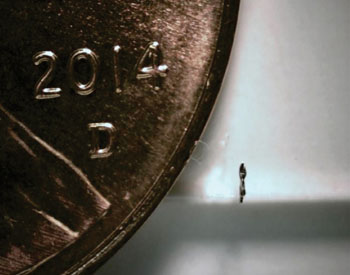Force-Sensing Microbots Designed to Probe Cells
By LabMedica International staff writers
Posted on 23 Oct 2014
Microrobots that have the capability of probing and engineering individual cells and tissue for biological research and medical applications are being constructed with technology that senses the minuscule forces exerted by a robot’s tiny probe. Posted on 23 Oct 2014
Microrobots small enough to interact with cells already exist. However, there is no easy, inexpensive way to measure the small forces applied to cells by the robots. Measuring these microforces is vital to precisely control the bots and to use them to study cells. “What is needed is a useful tool biologists can use every day and at low cost,” said David Cappelleri, an assistant professor of mechanical engineering at Purdue University (West Lafayette, IN, USA).

Image: Side view of the microrobot next to a US penny (Photo courtesy of Purdue University).
Researchers now have devised and constructed a “vision-based micro-force sensor end-effector,” which is attached to the microrobots similar to a tiny proboscis. A camera is used to measure the probe’s displacement while it pushes against cells, allowing a simple calculation that reveals the force applied.
The new strategy could make it possible to easily measure the micronewtons of force applied at the cellular level. Such a tool is needed to better study cells and to understand how they interact with microforces. The forces can be used to convert cells into specific cell lines, including stem cells for research and medical applications. Moreover, the measurement of microforces can be used to examine how cells respond to specific drugs and to diagnose disease.
“You want a device that is low-cost, that can measure micronewton-level forces and that can be easily integrated into standard experimental test beds,” Dr. Cappelleri said. Microrobots used in research are controlled with magnetic fields to move them into place. “But this is the first one with a truly functional end effector to measure microforces,” he said.
The study’s findings were presented during the International Conference on Intelligent Robots and Systems, held in Chicago (IL, USA), September 14–18, 2014.
The new system is combined with the microrobot is about 700 micrometers square, and the researchers are working to create versions about 500 micrometers square. “We are currently working on scaling it down,” Dr. Cappelleri said.
Future research, according to the investigators, also may concentrate on automating the microrobots. The system was fabricated at the Birck Nanotechnology Center in Purdue’s Discovery Park.
Related Links:
Purdue University













